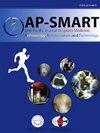Arthroscopic T-shaped biceps tenotomy decreased risk of Popeye deformity compared to traditional biceps tenotomy
IF 1.4
Q3 ORTHOPEDICS
Asia-Pacific Journal of Sport Medicine Arthroscopy Rehabilitation and Technology
Pub Date : 2025-09-09
DOI:10.1016/j.asmart.2025.08.002
引用次数: 0
Abstract
Purpose
This study compared the clinical efficacy of T-shaped biceps tenotomy (release of the long head of the biceps tendon with a portion of the superior labrum) with that of conventional cylinder-shaped biceps tenotomy (without the labrum) in patients with reparable rotator cuff tears and concomitant lesions of the long head of the biceps tendon.
Methods
Among patients who underwent arthroscopic repair of rotator cuff tears and concomitant lesions of the long head of the biceps tendon, 89 patients aged ≥65 years who were treated with T-shaped biceps tenotomy (group T; n = 46) or conventional cylinder-shaped biceps tenotomy (group C; n = 43) were evaluated. The presence of a Popeye deformity, severity of cramping pain, elbow flexion strength, and forearm supination strength were recorded. The anatomic status of the biceps stump was assessed through ultrasonography. Anatomic failure was considered when the biceps tendon was not identified in the intertubercular groove.
Results
Overall, 86 patients (45 in group T and 41 in group C) were monitored for more than 2 years. Their postoperative functional scores were significantly better than their preoperative scores (P < 0.03) and did not differ significantly between the two groups. Three patients (6.7 %) in group T and nine (22.0 %) in group C had a Popeye deformity (P = 0.036). Ultrasonography revealed anatomic failure in five patients (11.1 %) in group T and 13 (31.7 %) in group C (P = 0.021). Postoperative cramping pain and elbow flexion strength were evaluated, showing no significant differences between groups.
Conclusions
For treating concomitant LHBT lesions in patients with rotator cuff tears, T-shaped tenotomy involving a portion of the superior labrum is an acceptable alternative to conventional cylinder-shaped tenotomy not involving the labrum. T-shaped tenotomy is associated with similar functional outcome and lower occurrence rates of a postoperative Popeye deformity than conventional cylinder-shaped tenotomy.
Level of evidence
Level III, retrospective comparative study.
与传统的肱二头肌肌腱切断术相比,关节镜下t型肱二头肌肌腱切断术降低了大力水手畸形的风险
目的比较可修复性肩袖撕裂伴肱二头肌腱长头病变的t型肱二头肌腱切断术(将肱二头肌腱长头与部分上唇分离)与常规圆柱形肱二头肌腱切断术(不将肱二头肌腱上唇分离)的临床疗效。方法对经关节镜修复肩袖撕裂伴肱二头肌腱长头病变的89例≥65岁患者,分别采用T型肱二头肌腱切断术(T组,n = 46)和常规圆柱形肱二头肌腱切断术(C组,n = 43)进行评价。记录大力水手畸形的存在、痉挛疼痛的严重程度、肘关节屈曲强度和前臂旋后强度。通过超声检查评估肱二头肌残端解剖状态。当在结节间沟中未发现二头肌肌腱时,考虑解剖失败。结果86例患者(T组45例,C组41例)随访2年以上。术后功能评分明显优于术前评分(P < 0.03),两组间差异无统计学意义。T组3例(6.7%)出现大力水手畸形,C组9例(22.0%)出现大力水手畸形(P = 0.036)。超声检查发现T组解剖功能衰竭5例(11.1%),C组13例(31.7%)(P = 0.021)。术后痉挛疼痛和肘关节屈曲强度进行评估,各组间无显著差异。结论对于肩袖撕裂患者并发LHBT病变,累及部分上唇的t型肌腱切断术比不累及上唇的常规圆筒型肌腱切断术可接受。与传统的圆柱形肌腱切断术相比,t形肌腱切断术具有相似的功能结果和较低的术后大力水手畸形发生率。证据等级:III级,回顾性比较研究。
本文章由计算机程序翻译,如有差异,请以英文原文为准。
求助全文
约1分钟内获得全文
求助全文
来源期刊
CiteScore
3.80
自引率
0.00%
发文量
21
审稿时长
98 days
期刊介绍:
The Asia-Pacific Journal of Sports Medicine, Arthroscopy, Rehabilitation and Technology (AP-SMART) is the official peer-reviewed, open access journal of the Asia-Pacific Knee, Arthroscopy and Sports Medicine Society (APKASS) and the Japanese Orthopaedic Society of Knee, Arthroscopy and Sports Medicine (JOSKAS). It is published quarterly, in January, April, July and October, by Elsevier. The mission of AP-SMART is to inspire clinicians, practitioners, scientists and engineers to work towards a common goal to improve quality of life in the international community. The Journal publishes original research, reviews, editorials, perspectives, and letters to the Editor. Multidisciplinary research with collaboration amongst clinicians and scientists from different disciplines will be the trend in the coming decades. AP-SMART provides a platform for the exchange of new clinical and scientific information in the most precise and expeditious way to achieve timely dissemination of information and cross-fertilization of ideas.

 求助内容:
求助内容: 应助结果提醒方式:
应助结果提醒方式:


